Technology provider Wartsila has produced an updated version of one of its dual-fuel engines, which the company claims can cut methane emissions to the lowest of any engine on the market.
The company unveiled a new “ultra-low emissions version” of its medium speed, four-stroke Wartsila 31DF engine that it said — on a weighted average — can reduce methane emissions by 41% more than its existing version, which it said was “already the lowest emission levels on the market”.
Providing figures to TradeWinds, the company said the methane emissions – often referred to as methane slip – for the new version would be 1.7 grams per kW hour (g/kWh), down from 2.9 g/kWh in the existing one, which was first launched in 2015.
Wartsila is also claiming that operating on LNG, this new version can further reduce methane emissions on a 50% load point by up to 56% and NOx by up to 86%.
The company said this new updated version has already been installed as one of four engines onboard Wasaline’s 800-passenger ropax Aurora Botnia (built 2021). This has allowed the Finnish-Swedish ferry operator to reduce the ferry’s methane emissions by a further 10% — a reduction that has been assessed in an independent study, Wartsila said.
Juha Kytola, director of research & development and engineering at Wartsila, said the launch of the new engine was “significant for the market”.
Detailing its features, he said these technologies give a very stable combustion that consumes all the fuel evenly, giving ultra-low NOx emissions and very low methane slip. Any methane that does escape in the exhaust gases is used for powering the ship, which improves efficiency.
- Methane accounts for just over 17% of greenhouse gases.
- It is a short-lived greenhouse gas, with an average lifetime in the atmosphere of about 12 years, but it is more potent than CO2, albeit over that shorter time frame. One tonne of methane generates about 28 times the amount of warming as the equivalent amount of CO2.
- So tackling methane emissions can present a quick-fire way to tackle greenhouse gas emissions.
Answering questions, Kytola described the new version of the 31DF as “a very well-behaving engine” and said it is more stable over the whole load range than typical engines.
Kytola said the existing 31DF engine is also highly modular and can be modified for this new technology in what he described as “typical upgrade work”, which for the single unit on the Aurora Botnia was carried out while the ship was in operation.
Floating lab
Jonas Teir, technical director at Wasaline, said the aim was to make the Aurora Botnia, which was designed to work as a floating lab for Wartsila, the most environmentally friendly ferry in the world.
He said the new version of the engine opens up the opportunity for the company to sail without emissions when it is using biogas. But he added that from 2026, when the European Union’s Emissions Trading System kicks in, it will also have a monetary effect.
Teir revealed that Wasaline is close to starting discussions with Wartsila about the order in which to upgrade the other three engines onboard the ferry to the new lower-emission version.

Kytola said Wartsila has also launched smaller and larger engines in the same family, and these are following the same structure so the concept of how to upgrade them is now known how to improve.
He described LNG as a “very good transition fuel” for moving away from other existing liquid fossil fuels as it already reduces emissions and offers opportunities for the use of biogas or synthetic gas with the same assets.
Kytola said the same engine technology can be offered for other fuels such as methanol and ammonia. He revealed that Wartsila is planning to come out with a product on ammonia this year but said it has not been launched yet.
Stefan Nysjo, vice president of Wartsila Marine Power, described the new engine innovation as “one more very important step along the road to decarbonisation”.
Peter Stahlberg, managing director of Wasaline, said: “We are very committed to decarbonisation, and we have worked closely with Wartsila to make sustainable shipping a reality.”







